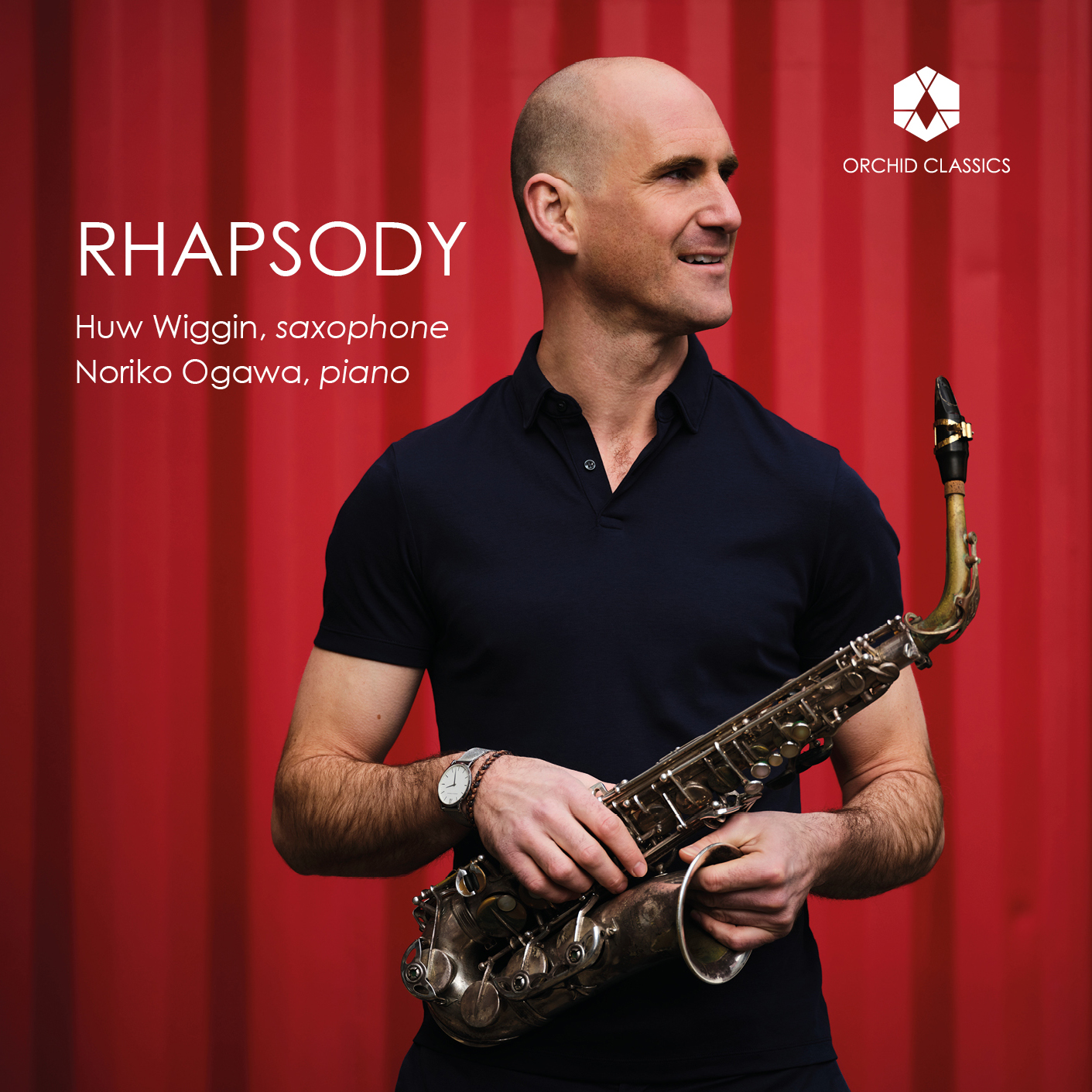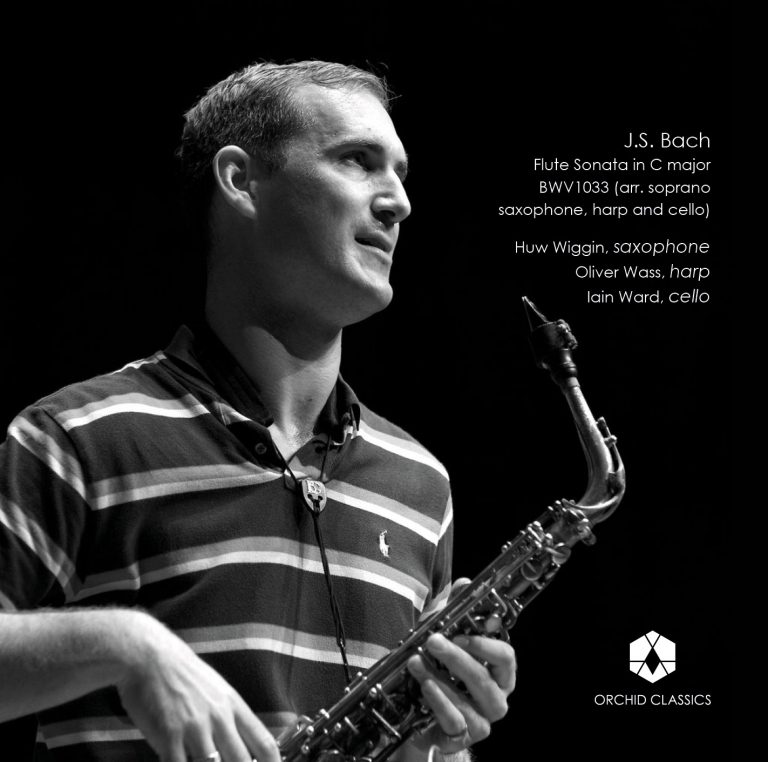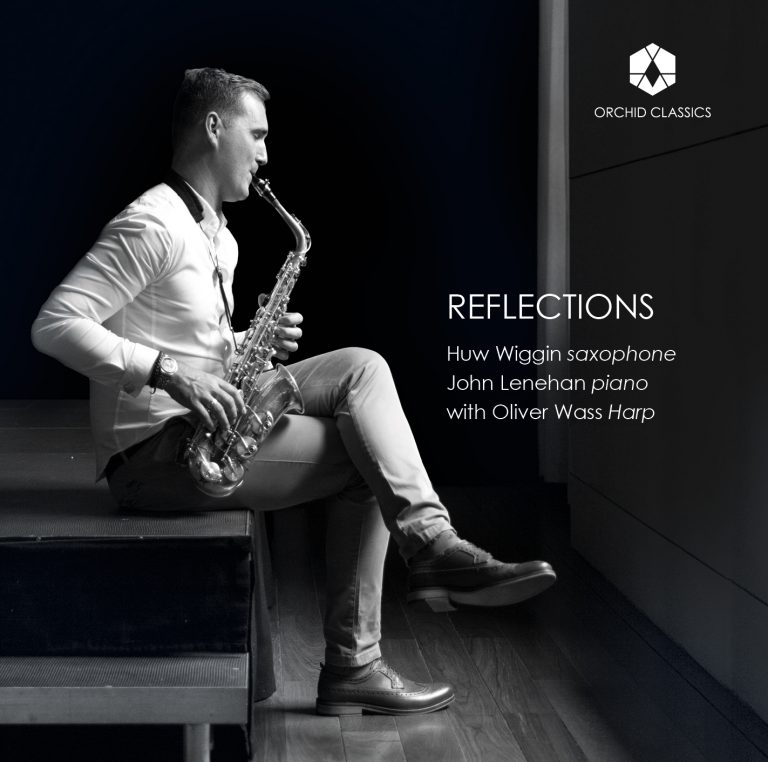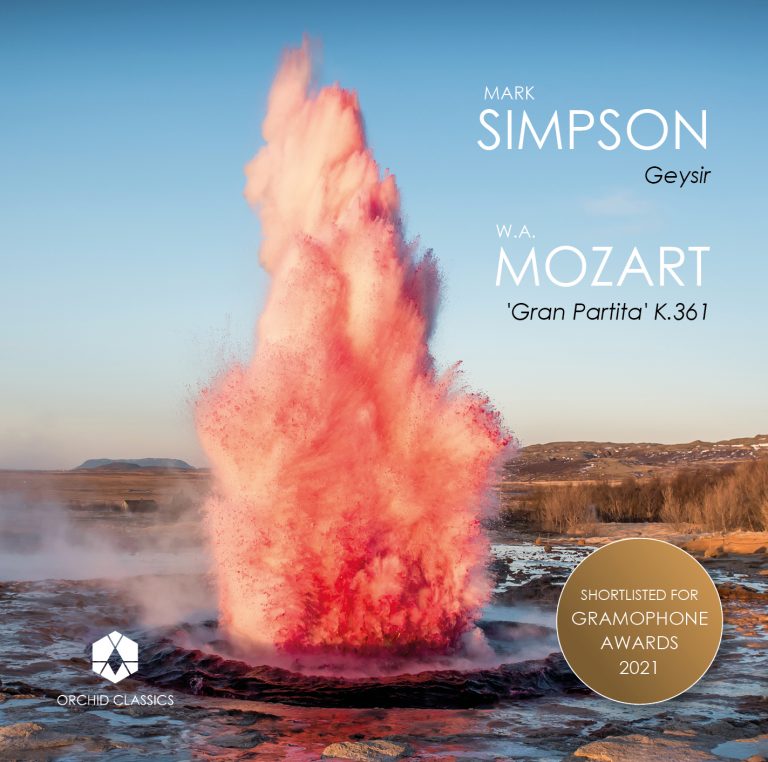Artist Led, Creatively Driven

RHAPSODY
Huw Wiggin, saxophone
Noriko Ogawa, piano
Release Date: March 17th
ORC100216
RHAPSODY
Claude Debussy (1862-1918)
1. Rapsodie pour orchestra et saxophone
Arranged by Vincent David
Joseph Phibbs (b.1974)
2. Night Paths
Iain Farrington (b.1977)
Paganini Patterns
3. I Lively
4. II Free and expressive
5. III Lively
Eric Coates (1886-1957)
6. Saxo – Rhapsody
Jennifer Watson (b.1985)
Rhapsody on an Echo Chamber
7. I
8. II
9. III
Franz Liszt (1811-1886)
10. Hungarian Rhapsody No.2 in C-sharp minor
Arranged by Iain Farrington
Huw Wiggin, saxophone
Noriko Ogawa, piano
Rhapsody is a collection of original works and commissioned pieces for saxophone and piano. One of the most prolific works for saxophone is Debussy’s Rhapsody which was the inspiration for this album. I first met Noriko Ogawa during a tour of Hong Kong in 2018 and following the trip we decided to record an album together. We then met in between lockdowns and remotely in 2020, discussing a concept for the album. Commissioning new music is very important to both of us and deciding on the composers fell into place very easily. Joseph Phibbs had written for Noriko before; Iain Farrington I have worked with many times and for a long time I have wanted to commission my school friend and colleague Jenni Watson. Each of the pieces on the album display the saxophone in different styles and moods, showcasing its versatility.
Huw Wiggin
Claude Debussy (1862-1918)
Rapsodie pour orchestra et saxophone
Claude Debussy was one of the earlier composers to bring the saxophone centre stage in his Rapsodie for ‘orchestra and saxophone’ (in that order), although his choice stemmed from financial necessity more than artistic innovation. The work was commissioned in 1901 by Elise Hall, dubbed ‘the saxophone lady’ by Debussy. Hall was a wealthy American musician and patron of the arts who had been born in Paris and who lived in Boston. She had taken up the saxophone at the recommendation of her physician husband, but was aghast at the lack of repertoire for her instrument. Debussy enthusiastically accepted the prepaid commission but struggled to complete it. Hall arrived in Paris to chase the work; a harried Debussy likened her to the looming Commendatore in Mozart’s Don Giovanni, adding that she was an “old bat who dresses like an umbrella”. Debussy never orchestrated the piece, but still sold it to the publisher Durand – he was paid twice for an incomplete commission. Eventually Jean Roger-Ducasse realised the orchestration and the work was premiered in 1919, by which time Debussy had died and Hall’s hearing had failed. We hear a further arrangement for saxophone and piano by Vincent David. Despite its difficult genesis, the Rapsodie has many of the hallmarks of Debussy’s style: rich whole-tone lines and harmonies, Spanish rhythms and, reflecting his affinity with wind instruments, mellifluous writing for the saxophone.
© Joanna Wyld, 2022
Joseph Phibbs (b.1974)
Night Paths (Rhapsody for alto saxophone and piano)
I’ve always felt the saxophone to be a deeply expressive instrument, yet one tinged with feelings of solitude, even loneliness. These qualities, combined with its urban, nocturnal associations (the busker on a street corner, or in the underground), find expression in this single movement work, whose free-flowing character and wide range of moods resembles a rhapsody. Within this continuous span there are five main sections: Passacaglia, Neon, Lumina, and Blues, followed by a short coda. The piano provides a range of backdrops – some frenetic, others very still – through which the saxophone passes.
Shortly after completing the piece, I came across a line by the writer Nicholas Heiney (1982-2006) which seemed to sum up the mood of piece perfectly: “Remember how the streets ring out for every soul that thought and felt and passed through them in weakness and in strength”.
Night Paths is dedicated with much admiration to Huw Wiggin, who commissioned the work.
Joseph Phibbs
Iain Farrington (b.1977)
Paganini Patterns
Paganini Patterns is a three-section piece based on the 24th Caprice by the renowned virtuoso violinist Niccolò Paganini. It was composed in 2022 for Huw Wiggin and Noriko Ogawa. Paganini’s original piece consists of a theme and variations, and has inspired a multitude of reworkings, arrangements and new compositions. Rachmaninoff’s Rhapsody on a theme of Paganini is one of the most famous examples, and one that ties in with the Rhapsody theme of this album. While many of the pieces based on Paganini’s theme use variation form, Paganini Patterns uses the melodic theme as the principal material for a short Sonata-type work. There is a strong jazz character to the music, well-suited to the soprano saxophone and piano. The first section has sonata-form characteristics, using a first subject group, development, recapitulation, and coda. A funk rhythmic and harmonic groove gives the music its energy. The second section takes the listener into a world of the night-club, with a smoky after-hours atmosphere. Paganini’s theme is transformed into a bluesy and wistful ballad. The third and final section uses the main theme interspersed with free saxophone solos, in a jazz rondo form. A walking bass and jabbed chords in the piano drive the jazz mood throughout.
Iain Farrington
Eric Coates (1886-1957)
Rhapsody
Known to many for By the Sleepy Lagoon – the theme used for BBC Radio 4’s Desert Island Discs – British composer Eric Coates reflected and to some extent defined the music of the 1920s and 1930s. His output has undergone both renaissance and re-evaluation in recent years, when ‘light music’ has increasingly been recognised not as some lesser satellite to the more serious classical repertoire, but as a highly skilful and hugely pleasurable genre in its own right. Eric Coates was a fine viola player, and his experience playing in various prestigious orchestras gave him a thorough grounding in creating orchestral balance and colour. He was also practical, often writing for the recording studio and radio. Coates’s virtuoso Saxo – Rhapsody (1936) is one of the major works for saxophone of this era, when the instrument, still relatively new and so integral to jazz, was enjoying the spotlight in the classical arena as well. The work opens with Coates’s characteristically genial harmonies before the saxophone unfurls a rich array of melodic material, ranging from wistful anticipation to sophisticated showmanship.
© Joanna Wyld, 2022
Jennifer Watson (b.1985)
Rhapsody on an Echo Chamber
Rhapsody on an Echo Chamber is a reflection on isolation, particularly in areas of natural beauty, such as caves or forests. Such isolation can lead to a myriad of thoughts and emotions across a spectrum of both positive and negative outlooks, but often results in somewhat of a personal echo chamber once certain ideas, themes and motifs begin to crystallise and repeat themselves, without outside influence to sway or broaden our way of thinking. We can begin to convince ourselves that our inner voice is true, or that our course of action is the correct one to take. This too can be a positive or negative experience, perhaps depending on what the subconscious was already thinking before being alone with thoughts in an open space.
The piece, in three continuous movements, is a constant, journeying narrative that plays with the representation of repeated ideas across a spectrum of emotions.
Jennifer Watson
Franz Liszt (1811-1886)
Hungarian Rhapsody No.2 in C-sharp minor
Liszt reflected his nationality in various ways, incorporating gypsy music and Hungarian folksong into some works, and in others paying tribute to significant Hungarian figures. Liszt renewed his interest in gypsy and Hungarian folk music in 1840, visiting a gypsy dwelling and writing a vivid account of the people he encountered there, as well as listening to a number of outstanding gypsy bands. These experiences inspired a series of pieces called Magyar dallok (‘Hungarian National Melodies’), which Liszt later revised and published under the more poetic title Hungarian Rhapsodies (1851-53). The Hungarian Rhapsody No.2 in C-sharp minor is the most famous of the set and is dedicated to László Teleki, a writer and statesman. The piece is derived from the Hungarian csárdás dance style, opening with a stately ‘lassan’ section, solemn and proud, followed by the lively, rhythmic ‘friska’, which steadily gains momentum. The piece was so popular after its publication that it was quickly arranged for different combinations and has since been heard on numerous instruments – including, thanks to Iain Farrington, the saxophone.
© Joanna Wyld, 2022
Huw Wiggin
Saxophone
Huw Wiggin has performed in venues all over the world, from the Forbidden City Concert Hall in Beijing as well as those closer to home such as London’s Wigmore Hall. Other highlights include performances at the Royal Festival Hall, St John’s Smith Square, Henley, Ryedale, Newbury and Edinburgh Fringe Festivals.
Following his debut at London’s Purcell Room he was praised by the Times for his “liquid gold tones and enviable breath control”.
Since winning First Prize and Gold Medal and being named ‘Commonwealth Musician of the Year’ at the Royal Over-Seas League Annual Music Competition in 2014, Huw has developed a career as a soloist and chamber musician. ‘Reflections’ – Huw’s debut disc on Orchid Classics in 2018 (with John Lenehan and Oliver Wass) – reached no.2 in the UK Specialist Classical Chart. BBC Music Magazine praised Huw for bringing “dazzling flair and imagination to his performance”.
He is a professor of saxophone at the Royal Academy of Music in London and regularly gives masterclasses at conservatoires in the UK and abroad. Huw gained a Master’s degree with Distinction from the Royal College of Music in 2012. Huw is a Vandoren UK Artist.
Noriko Ogawa
Piano
‘…pianism of the highest order’ – The Times.
‘ravishingly poetic playing’ – The Telegraph (for her complete Debussy series.)
Noriko boasts a prolific catalogue of over 35 albums from BIS Records: Mozart, Debussy, Rachmaninov, Holmboe, Kanno, Dubugnon…
Noriko appears with all the major orchestras including the BBC Symphony Orchestra, BBC Philharmonic Orchestra, NHK Symphony Orchestra, Tokyo Symphony Orchestra, and St. Petersburg Symphony Orchestra.
She is a renowned recitalist and chamber musician, performing with artists such as Evelyn Glennie, Michael Collins, Peter Donohoe, Martin Roscoe, and Huw Wiggin. Noriko made a debut at the 2013 BBC Proms performing with Kathryn Stott.
Noriko is the Chairperson of the Jury for the Hamamatsu International Piano Competition. She has been elected to the board of the World Federation of International Music Competitions. Noriko is a professor at Guildhall School of Music and Drama. She is the Music Director of Hamamatsu International Piano Academy, Advisor of Muza Kawasaki Symphony Hall, and Music Director of Jamie’s Concerts.
Joseph Phibbs was born in London, and studied at The Purcell School, King’s College London, and Cornell University. His teachers have included Param Vir, Sir Harrison Birtwistle, and Steven Stucky.
Described by BBC Music Magazine as “one of the most successful composers of his generation”, Phibbs’s orchestral works have been commissioned by BBC Symphony Orchestra, Philharmonia, and London Symphony Orchestra and championed by conductors such as Edward Gardner, Gianandrea Noseda, Sakari Oramo, Vassily Petrenko, Esa-Pekka Salonen, and Leonard Slatkin.
His instrumental music comprises song cycles, sonatas, and several string quartets (the third a three-way commission between Carnegie Hall, Wigmore Hall, and Belcea Quartet), and is heard regularly at Wigmore Hall, Three Choirs Festival, Hatfield House Chamber Music Festival, and Presteigne Festival.
In 2021 his first chamber opera, Juliana (commissioned by Nova Music Opera/Cheltenham Festival, to a libretto by Laurie Slade, and premiered under George Vass) was released on Resonus Classics to widespread critical acclaim. He has also composed choral music for groups such as Tenebrae, The Sixteen, and ORA Singers.
Future commissions include a Cello Concerto for Guy Johnston/BBC SO, and works for the Britten Sinfonia, Piatti Quartet, Noriko Ogawa, Ben Goldscheider, and Mark van de Wiel.
Iain Farrington has an exceptionally busy and diverse career as a pianist, organist, composer and arranger. He studied at the Royal Academy of Music, London and at Cambridge University. He has made numerous recordings, and has broadcast on BBC Television, Classic FM and BBC Radio 3. Iain played the piano at the opening ceremony of the London 2012 Olympics with Rowan Atkinson, the London Symphony Orchestra and Sir Simon Rattle. Iain has composed film, opera, ballet, orchestral, choral and instrumental pieces and has arranged hundreds of works in many styles, including opera, orchestral, choral, African songs, cabaret, klezmer, jazz and pop. His music often mixes jazz and popular elements into a modern Classical style. With the poet, DJ and actor Craig Charles, he has written two large-scale orchestral works based on traditional fairytales. Iain has composed numerous orchestral works for the BBC Proms, including A Party with Auntie in 2022, Beethoveniana in 2020, Gershwinicity in 2018, and two works for the Wallace and Gromit Prom in 2012. His chamber orchestrations of the symphonic repertoire are regularly performed around the world and his organ arrangement of Elgar’s Pomp and Circumstance March No.5 was performed at the Royal Wedding in 2011. He has arranged and performed many of the Mahler and Elgar symphonies for solo piano.
Jennifer Watson is a saxophonist and composer who enjoys blending sound by merging genres and softening their boundaries. Her works gain popularity through combining emotional accessibility with multi-layered depth and richness of texture.
With a predominantly classical music foundation under a love of many wide-ranging genres, Jenni focusses on utilising such techniques as a means to tell emotive stories. Increasingly her works explore the marriage of her own acoustic multi-instrumental recordings with an exploration into electronic manipulation and found sound.
Although known for her works for saxophone, other commissions have included writing for choir, brass quintet and wind ensemble.
Aside from composition commissions and writing music for screen, she performs with her duo partner Martin Jacoby (piano) and as tenor saxophonist with the Kaleidoscope Saxophone Quartet. She has a passion for committing her own personal creative projects to disc, most often in a multi-instrumental capacity.
Jenni studied with Andrew Wilson at Chetham’s School of Music and with Rob Buckland and Andy Scott at the Royal Northern College of Music, where she achieved her MMus. The majority of her music is self-published, with some titles also available from Astute Music.
www.jenniwatson.com










